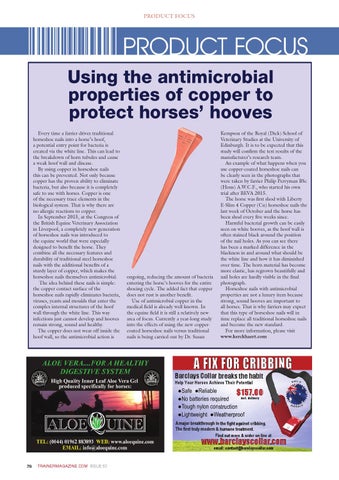PRODUCT FOCUS
Using the antimicrobial properties of copper to protect horses’ hooves Every time a farrier drives traditional horseshoe nails into a horse’s hoof, a potential entry point for bacteria is created via the white line. This can lead to the breakdown of horn tubules and cause a weak hoof wall and disease. By using copper in horseshoe nails this can be prevented. Not only because copper has the proven ability to eliminate bacteria, but also because it is completely safe to use with horses. Copper is one of the necessary trace elements in the biological system. That is why there are no allergic reactions to copper. In September 2015, at the Congress of the British Equine Veterinary Association in Liverpool, a completely new generation of horseshoe nails was introduced to the equine world that were especially designed to benefit the horse. They combine all the necessary features and durability of traditional steel horseshoe nails with the additional benefits of a sturdy layer of copper, which makes the horseshoe nails themselves antimicrobial. The idea behind these nails is simple: the copper contact surface of the horseshoe nails rapidly eliminates bacteria, viruses, yeasts and moulds that enter the complex internal structures of the hoof wall through the white line. This way infections just cannot develop and hooves remain strong, sound and healthy. The copper does not wear off inside the hoof wall, so the antimicrobial action is
ongoing, reducing the amount of bacteria entering the horse’s hooves for the entire shoeing cycle. The added fact that copper does not rust is another benefit. Use of antimicrobial copper in the medical field is already well known. In the equine field it is still a relatively new area of focus. Currently a year-long study into the effects of using the new coppercoated horseshoe nails versus traditional nails is being carried out by Dr. Susan
Kempson of the Royal (Dick) School of Veterinary Studies at the University of Edinburgh. It is to be expected that this study will confirm the test results of the manufacturer’s research team. An example of what happens when you use copper-coated horseshoe nails can be clearly seen in the photographs that were taken by farrier Philip Perryman BSc (Hons) A.W.C.F., who started his own trial after BEVA 2015. The horse was first shod with Liberty E-Slim 4 Copper (Cu) horseshoe nails the last week of October and the horse has been shod every five weeks since. Harmful bacterial growth can be easily seen on white hooves, as the hoof wall is often stained black around the position of the nail holes. As you can see there has been a marked difference in the blackness in and around what should be the white line and how it has diminished over time. The horn material has become more elastic, has regrown beautifully and nail holes are hardly visible in the final photograph. Horseshoe nails with antimicrobial properties are not a luxury item because strong, sound hooves are important to all horses. That is why farriers may expect that this type of horseshoe nails will in time replace all traditional horseshoe nails and become the new standard. For more information, please visit www.kerckhaert.com
A FIX FOR CRIBBING
Barclays Collar breaks the habit
Help Your Horses Achieve Their Potential
●Safe ●Reliable $157.00 incl. delivery No batteries required ●No Tough nylon construction ●Tough Weatherproof ●Lightweight ●Weatherproof A major breakthrough in the fight against cribbing. The first truly modern & humane treatment.
Find out more & order on line at
www.barclayscollar.com w.barclayscollar.com r.com email: contact@barclayscollar.com
78
TRAINERMAGAZINE.COM ISSUE 53
MADE IN
AU
STRALIA
